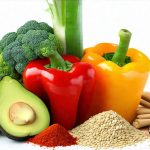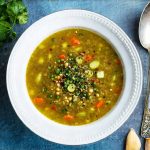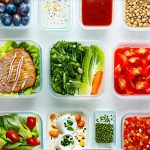Our gut is often an afterthought in wellness conversations, yet it’s foundational to overall health. We frequently focus on what we add to our diets – superfoods, supplements, trendy ingredients – but rarely consider the power of strategically removing things and allowing the digestive system a period of gentle restoration. Many “detox” programs promise rapid results with restrictive diets and often unpleasant side effects. This approach can be unnecessarily harsh and even detrimental in the long run. Instead, we can build a weekly menu focused on nurturing gut health through mindful eating choices that prioritize ease of digestion, reduce inflammation, and support a balanced microbiome – all without extreme deprivation or suffering. It’s about creating sustainable habits, not temporary fixes.
This isn’t about eliminating entire food groups or enduring juice cleanses; it’s about intentionally designing meals that give your gut a break from constant processing and potential irritants. Think of it as giving your digestive system a “reset” button – a weekly opportunity to recalibrate and function optimally. This approach acknowledges the interconnectedness between our diet, gut microbiome, and overall wellbeing, recognizing that a happy gut contributes significantly to improved energy levels, better mood, enhanced immunity, and even clearer skin. The key lies in understanding which foods are generally easier on the digestive system and incorporating them thoughtfully into your weekly meal plan. You can explore more about building a digestive routine to support long-term health https://vitagastro.com/building-a-digestive-routine-to-support-gut-health-in-the-long-term/.
Understanding Gentle Gut Reset Principles
A gentle reset isn’t about deprivation; it’s about strategic selection. It focuses on reducing common gut irritants while simultaneously nourishing beneficial bacteria. This means leaning heavily towards whole, unprocessed foods that are easily digestible. The aim is to minimize the workload of your digestive system allowing it time to repair and rebuild a healthy microbial balance. Inflammation is often at the root of many gut issues, so minimizing inflammatory foods is crucial. It’s also important to understand that everyone reacts differently to certain foods; what bothers one person may not affect another. This weekly menu serves as a starting point – you can tailor it based on your individual needs and sensitivities.
The foundation of this reset lies in recognizing the difference between foods that fuel inflammation and those that support gut health. Highly processed foods, excessive sugar intake, artificial sweeteners, and an overabundance of refined carbohydrates are all known to disrupt the gut microbiome and contribute to inflammation. Conversely, fiber-rich vegetables, lean proteins, healthy fats, and fermented foods actively promote a thriving gut ecosystem. Prioritizing nutrient density is vital – focusing on foods that offer maximum nutritional value with minimal digestive burden. Think about incorporating more soups, stews, steamed vegetables, and easily digestible protein sources like fish or poultry. It can be helpful to explore foods that naturally detox the gut https://vitagastro.com/foods-that-naturally-detox-the-gut/ for inspiration.
Ultimately, the goal isn’t to eliminate these “trigger” foods forever (unless you have a diagnosed intolerance), but rather to create space for your gut to heal and rebalance. A weekly reset allows you to identify potential sensitivities and observe how different food choices impact your overall wellbeing. It’s about building awareness and developing a more conscious relationship with the food you consume – moving beyond simply eating what tastes good to understanding how it affects your body on a deeper level. If you struggle with digestive discomfort, consider building a life https://vitagastro.com/building-a-life-that-doesnt-revolve-around-the-bathroom/ that doesn’t revolve around the bathroom.
Building Your Weekly Menu: Key Food Groups
The success of this gentle reset hinges on incorporating specific food groups that are known to support gut health. These aren’t necessarily “new” or exotic foods, but rather familiar staples prepared in ways that prioritize digestibility.
- Vegetables: Non-starchy vegetables should form the bulk of your meals. Think leafy greens (spinach, kale, lettuce), cruciferous vegetables (broccoli, cauliflower, cabbage – potentially steaming to aid digestion), root vegetables (sweet potatoes, carrots) and squashes. Focus on cooked rather than raw vegetables during the reset period for easier digestion.
- Lean Proteins: Choose easily digestible protein sources like fish (salmon, cod, halibut), poultry (chicken breast, turkey), eggs, and tofu. Avoid red meat or limit it significantly due to its potential digestive complexity.
- Healthy Fats: Incorporate healthy fats from sources such as avocado, olive oil, nuts and seeds (in moderation – chia seeds, flaxseeds are particularly good for gut health). These fats support overall health and can aid in nutrient absorption.
- Fermented Foods: Introduce small amounts of fermented foods like yogurt (unsweetened), kefir, sauerkraut, kimchi or kombucha to help repopulate your gut with beneficial bacteria. Start slowly as some people may experience digestive upset initially.
A crucial component is hydration. Drinking plenty of water throughout the day helps maintain a healthy digestive system and facilitates waste removal. Aim for at least eight glasses of water daily. Also, consider incorporating herbal teas like ginger or peppermint tea to soothe digestion. Avoid sugary drinks and excessive caffeine which can disrupt gut function. For inspiration on meal planning, you might find it useful to learn how to create a weekly menu https://vitagastro.com/how-to-create-a-weekly-menu-that-wont-trigger-discomfort/ that won’t trigger discomfort.
Sample Weekly Menu Structure
This is a sample structure; feel free to adapt it based on your preferences and dietary needs. The focus is on simplicity and ease of preparation. Each day features meals designed to minimize digestive stress and maximize nutrient absorption.
- Monday: Breakfast: Oatmeal with berries & almond butter. Lunch: Chicken soup with vegetables. Dinner: Baked salmon with steamed broccoli and quinoa.
- Tuesday: Breakfast: Yogurt (unsweetened) with a sprinkle of chia seeds. Lunch: Salad with grilled chicken or tofu, avocado & olive oil dressing. Dinner: Turkey meatballs with zucchini noodles & tomato sauce.
- Wednesday: Breakfast: Scrambled eggs with spinach. Lunch: Leftover turkey meatballs & zucchini noodles. Dinner: Cod baked with lemon and herbs, served with sweet potato mash.
- Thursday: Breakfast: Smoothie with spinach, banana, almond milk & flaxseeds. Lunch: Lentil soup with a side of steamed carrots. Dinner: Chicken breast with roasted asparagus and brown rice.
- Friday: Breakfast: Oatmeal with chopped apple and cinnamon. Lunch: Leftover chicken & asparagus. Dinner: Fish tacos with corn tortillas, avocado & salsa (mild).
- Saturday: Breakfast: Eggs poached on whole wheat toast with avocado. Lunch: Salad with salmon and mixed greens. Dinner: Vegetable stir-fry with tofu and brown rice.
- Sunday: Breakfast: Yogurt with berries and a handful of walnuts. Lunch: Leftover vegetable stir-fry. Dinner: Roasted chicken with roasted root vegetables (carrots, parsnips).
This menu emphasizes whole foods, lean proteins, healthy fats, and plenty of fiber. It minimizes processed foods, sugar, and potentially irritating ingredients. It’s also important to listen to your body – if you experience any digestive discomfort after eating a particular food, remove it from your diet. To aid in planning, you can review how to build a gut friendly menu https://vitagastro.com/how-to-build-a-weekly-gut-friendly-menu/.
Reintegration & Long-Term Maintenance
After the week-long reset, gradually reintroduce previously eliminated foods one at a time, paying close attention to how your body responds. This is where the real learning happens. Keep a food journal to track what you eat and any associated symptoms (bloating, gas, fatigue, skin breakouts). If you notice a consistent reaction to a specific food, it might be an indicator of sensitivity or intolerance.
- Slow & Steady: Reintroduce foods slowly, starting with small portions.
- Observe Carefully: Monitor your body for any signs of discomfort.
- Prioritize Gut Health: Continue incorporating gut-supportive foods into your regular diet (fiber-rich vegetables, fermented foods, healthy fats).
Boldly prioritize mindful eating: Pay attention to how different foods make you feel, both physically and mentally. This is about building a sustainable lifestyle that supports your overall wellbeing – not just for a week, but for the long term. The goal isn’t perfection; it’s progress. A gentle gut reset can be a powerful tool for reclaiming digestive health and enhancing your overall quality of life. Remember, consistency and self-awareness are key to lasting results. Consider also learning about one-pot meals https://vitagastro.com/guidelines-for-building-a-one-pot-meal-thats-easy-on-the-digestive-tract/ that are easy on the digestive tract.


















